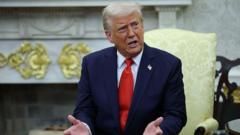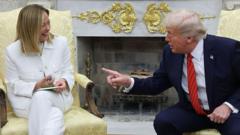The ongoing trade tensions between the US and China reflect a crucial shift in global economic dynamics driven by ongoing tariffs and negotiations.
**Trump's Trade War with China: A New Phase on the Horizon**

**Trump's Trade War with China: A New Phase on the Horizon**
Trump’s renewed focus on China intensifies amid trade negotiations and tariffs.
In a surprising turn, Donald Trump’s rhetoric regarding trade has refocused sharply on China, marking a distinct pivot in his ongoing trade war strategy. Instead of a broad conflict with multiple countries, this latest phase has crystallized into a clear dichotomy: America versus China, the world's second-largest economy and a significant player in global trade.
Currently, a 10% universal tariff remains in place for various countries, but China has emerged as the primary target, facing a staggering 125% tariff on its goods. Trump has justified these punitive measures, pointing to China’s corresponding retaliation with an 84% levy on US exports, viewing this as evidence of disrespect towards American trade policy.
For Trump, this action is far from mere retaliation—it's part of a broader effort to address what he perceives as unfinished business from his first term. He expressed his conviction that his administration is taking the necessary steps to rectify past inadequacies.
Historically, engagement with China was largely seen as beneficial. Trade partnerships were assumed to cultivate economic expansion and support China’s ascension towards becoming a consumer-driven market. However, as China's global economic standing has evolved—now producing 60% of the world's electric vehicles—it has also gained political power, contrary to expectations that such wealth would lead to demands for reform.
Trump’s rise to power resonated with discontent over America's economic decline, particularly among blue-collar workers who felt marginalized by globalization and trade agreements. His previous tariffs shattered the long-held consensus on trade, with President Biden maintaining many of these tariffs in an attempt to address similar concerns.
The current predicament leads to critical questions about future trade negotiations: Will China agree to engage in talks? If they do, can they make the sweeping changes that the US demands, particularly altering their heavily export-driven economic model?
Speculations on China's reaction suggest a hesitance based on their vested interest in maintaining a robust export framework that supports national growth and consolidates their political ideology. The potential for a robust negotiation hinges on both nations' willingness to recalibrate their stances.
Moreover, there's a pivotal inquiry for the US to confront: Does America still uphold the principles of free trade, or are tariffs now regarded as a central economic strategy? Trump's framing of tariffs as beneficial may indicate a shift away from multilateral cooperation towards a zero-sum game, where the world's two leading powers could engage in a contentious contest for economic dominance.
Consequently, if this trend persists, it could signal an unprecedented transformation in the global trading landscape, potentially ushering in an era marked by heightened competition and uncertainty.
Currently, a 10% universal tariff remains in place for various countries, but China has emerged as the primary target, facing a staggering 125% tariff on its goods. Trump has justified these punitive measures, pointing to China’s corresponding retaliation with an 84% levy on US exports, viewing this as evidence of disrespect towards American trade policy.
For Trump, this action is far from mere retaliation—it's part of a broader effort to address what he perceives as unfinished business from his first term. He expressed his conviction that his administration is taking the necessary steps to rectify past inadequacies.
Historically, engagement with China was largely seen as beneficial. Trade partnerships were assumed to cultivate economic expansion and support China’s ascension towards becoming a consumer-driven market. However, as China's global economic standing has evolved—now producing 60% of the world's electric vehicles—it has also gained political power, contrary to expectations that such wealth would lead to demands for reform.
Trump’s rise to power resonated with discontent over America's economic decline, particularly among blue-collar workers who felt marginalized by globalization and trade agreements. His previous tariffs shattered the long-held consensus on trade, with President Biden maintaining many of these tariffs in an attempt to address similar concerns.
The current predicament leads to critical questions about future trade negotiations: Will China agree to engage in talks? If they do, can they make the sweeping changes that the US demands, particularly altering their heavily export-driven economic model?
Speculations on China's reaction suggest a hesitance based on their vested interest in maintaining a robust export framework that supports national growth and consolidates their political ideology. The potential for a robust negotiation hinges on both nations' willingness to recalibrate their stances.
Moreover, there's a pivotal inquiry for the US to confront: Does America still uphold the principles of free trade, or are tariffs now regarded as a central economic strategy? Trump's framing of tariffs as beneficial may indicate a shift away from multilateral cooperation towards a zero-sum game, where the world's two leading powers could engage in a contentious contest for economic dominance.
Consequently, if this trend persists, it could signal an unprecedented transformation in the global trading landscape, potentially ushering in an era marked by heightened competition and uncertainty.





















